43 books for « motier r »Edit
-
Century
18th (1)
19th (3)
20th (19)
-
Countries
Belgium (1)
France (40)
Germany (1)
Switzerland (1)
-
Syndicate
CLAM (1)
ILAB (23)
SLAM (22)
SNCAO (1)
Topics
- Adam (1)
- Autographs (1)
- Biography (1)
- Budget (1)
- Collaboration (1)
- Correspondences (1)
- Criminology (1)
- Ethic (1)
- Ethnology (1)
- Finances (1)
- First edition (1)
- Geneva (4)
- Grenadier (1)
- History (3)
- Humour anecdotes (3)
- Journalism (1)
- La fayette (2)
- Literature (1)
- Morin edgar (1)
- Motier romain (11)
- Navy (1)
- Newspapers press (1)
- Paris (1)
- Philosophy (2)
- Physiocrats (1)
- Revolution 1789 (2)
- Revolution 1830 (1)
- Sociology (3)
- Tea (1)
- United states (2)
- War (3)
LA FAYETTE (Gilbert du Motier de), POIREY (Joseph-Léonard), BAILLY (Jean Sylvain), BOULA (Guillaume-Sylvain).
Reference : 4503
(1791)
Brevet de lieutenant de chasseurs volontaires de la Garde Nationale Parisienne.
Hotel de ville de Paris, 1er et 6 septembre 1791. 1791 1 feuille in-folio manuscrite à l'encre brune recto-verso (382 X 246 mm.) signée Henry, La Fayette, Bailly, Poirey et Dejoly, cachet en bas à droite (traces de plis avec cassures ancienement restaurées, taches ou traces d'adésif ). Chemise de papier ancien.
Brevet de lieutenant de la Garde Nationale Parisienne portant les signatures de Bailly, premier maire de Paris, de La Fayette, commandent fondateur de la garde et de Joseph-Léonard POIREY, son ancien compagnon darmes de la Guerre dAmérique, alors secrétaire général des Gardes nationales, document raturé postérieurement. Marie Joseph Paul Yves Roch Gilbert Motier, marquis de La Fayette (1757-1834), auréolé par son héroïsme à défendre les libertés pendant la guerre dindépendance américaine, est en 1789 le fondateur de la Garde nationale à Paris le 15 juillet 1789. Il en demeure le général jusquà sa démission le 8 octobre 1791 suite aux troubles révolutionnaires survenus les mois précédents. Joseph-Léonard Poirey (1748- , qui fut son secrétaire militaire pendant la Révolution américaine, participe à aux batailles à Petersburg, Jamestown et Yorktown. Rentré en France avec Lafayette, il sert comme capitaine secrétaire général de la Garde nationale française fin 1789 et ensuite secrétaire général des troupes parisiennes. En 1790, le Sénat des États-Unis confirme la nomination de Poirey par le président George Washington au grade de brevet de capitaine et, l'année suivante, il est admis dans la Society of the Cincinnati. George Washington écrit au sénat le 30 mai 1790 : « M. de Poirey served in the American Army for several of the last years of the late war, as Secretary to Major General the Marquis de la Fayette, and might probably at that time have obtained the Commission of Captain from Congress upon application to that Body. At present he is an officer in the French National Guards, and solicits a Brevet Commission from the United States of America. I am authorised to add, that, while the compliance will involve no expense on our part, it will be particularly grateful to that friend of America, the Marquis de la Fayette. Et La Fayette écrira le 20 avril 1801. « I do but justice to Captain [Joseph-Léonard] Poirey when being called upon as a witness of his services in the American Revolution... » Jean Sylvain Bailly (1736-1793), mathématicien, astronome, académicien, écrivain est désigné maire de Paris le 15 juillet 1789 par acclamation. C'est à ce titre qu'il remet la cocarde tricolore au roi, lors de la visite que celui-ci rend à l'hôtel de ville, le 17 juillet. Le 17 juillet 1791, la Garde nationale, sous ses ordres, tire sur les pétitionnaires qui se tiennent sur le Champ-de-Mars. Sa popularité tombe au plus bas et le 12 novembre, il démissionne. Le présent brevet établis au nom du lieutenant Guillaume-Sylvain Boula étant rédigé au début du mois de septembre 1791, il porte les signatures de Bailly et de La Fayette alors en fonction. Sy ajoute celle du greffier (Dejoly). Cependant, celle du général a été postérieurement barrée ainsi que les mots imprimés « Par Monsieur le Maire » et « Général ». Rare et beau document. 1 sheet in-folio handwritten in brown ink on both sides (382 X 246 mm.) signed Henry, La Fayette, Bailly, Poirey and Dejoly, stamped at the bottom right corner (traces of folds with old restored breaks, stains or traces of adesif ). Old paper folder. Patent of lieutenant of the Parisian National Guard bearing the signatures of Bailly, first mayor of Paris, of La Fayette, founding commander of the guard and of Joseph-Léonard POIREY, his former comrade-in-arms of the American War, then secretary general of the National Guard, document erased later. Marie Joseph Paul Yves Roch Gilbert Motier, marquis de La Fayette (1757-1834), honored by his heroism in defending liberties during the American war of independence, was the founder of the National Guard in Paris on July 15, 1789. He remained its general until his resignation on October 8, 1791, following the revolutionary unrest of the previous months. Joseph-Léonard Poirey (1748- , who was his military secretary during the American Revolution, participated in the battles at Petersburg, Jamestown and Yorktown. Returning to France with Lafayette, he served as captain general secretary of the French National Guard at the end of 1789 and then general secretary of the Parisian troops. In 1790, the U.S. Senate confirmed President George Washington's appointment of Poirey to the rank of captain and the following year he was admitted to the Society of the Cincinnati. George Washington wrote to the Senate on May 30, 1790: "M. de Poirey served in the American Army for several of the last years of the late war, as Secretary to Major General the Marquis de la Fayette, and might probably at that time have obtained the Commission of Captain from Congress upon application to that Body. At present he is an officer in the French National Guards, and solicits a Brevet Commission from the United States of America. I am authorized to add, that, while the compliance will involve no expense on our part, it will be particularly grateful to that friend of America, the Marquis de la Fayette. And La Fayette will write on April 20, 1801. "I do but justice to Captain [Joseph-Léonard] Poirey when being called upon as a witness of his services in the American Revolution..." Jean Sylvain Bailly (1736-1793), mathematician, astronomer, academician, writer was appointed mayor of Paris on July 15, 1789 by acclamation. It was in this capacity that he gave the tricolor cockade to the king during the latter's visit to the town hall on July 17. On July 17, 1791, the National Guard, under his orders, shot at the petitioners who were standing on the Champ-de-Mars. His popularity fell to a low point and on November 12, he resigned. The present patent established in the name of lieutenant Guillaume-Sylvain Boula being written at the beginning of September 1791, it bears the signatures of Bailly and La Fayette then in office. The clerk's signature (Dejoly) is added to it. However, that of the general was later crossed out as well as the printed words "Par Monsieur le Maire" and "Général". Rare and beautiful document.


Phone number : 06 81 35 73 35
Cols bleus n° 120 - Deux batiments retour d'Indochine, le Savorgnan-de-Brazza et la Croix de Lorraine, L'amitié Franco-américaine a égé affirmée, La vie sera-t-elle un jour surbonnée aux richesses, La jeune fille de Tunis par Marcel Motier, La marine
Editions Marcel Daubin. 13 juin 1947. In-12. Broché. Bon état, Couv. convenable, Dos satisfaisant, Intérieur frais. 4 pages. Nombreuses illustrations en noir et blanc dans et hors texte.. . . . Classification Dewey : 386-Marine
Sommaire : Deux batiments retour d'Indochine, le Savorgnan-de-Brazza et la Croix de Lorraine, L'amitié Franco-américaine a égé affirmée, La vie sera-t-elle un jour surbonnée aux richesses, La jeune fille de Tunis par Marcel Motier, La marine a la foire de Bordeaux Classification Dewey : 386-Marine
MOTIER (Romain citoyen de Genève, pseudonyme de Roger PUTHOSTE alias André THÉRIVE)
Reference : 16377
(1947)
Traité de la délation. Avec un portrait de l'auteur
1947 Paris, Aux dépens des Amis de Romain Motier, 1947, in 16 de X-165-(3) pp., portrait photographique de l'auteur sur papier glacé en frontispice, rel. d'ép. demi-chagrin vert olive, dos à nerfs (passé), date en pied, couvert. et dos cons., bon ex.
Éd. orig., illustrée de dessins hors-texte en noir et de bandeaux, il n'est pas annoncé de grand papier. De son vrai nom Roger Puthoste (1891-1967) alias André Thérive comme nom de plume courant, ilécrivit sous d'autres pseudonymes, dont celui de Romain MOTIER citoyen de Genève. Cet auteur totalement oublié, fut un auteur très prolifique, journaliste, critique littéraire, romancier, essayiste… il est aussi l’auteur, parmi bien d’autres d’ouvrages de critique sociale, dans les années de "l'Épuration", d'un traité de l'intolérance et de l’essai sur les trahisons. C’est un auteur de grande lucidité pessimiste, mais qui peut être primesautier, ironique, n’ayant aucune illusion sur l’humanité.
Traité de la Délation par Romain Motier citoyen de Genève(De la délation en général - le vice national des français - Du sens civique - Du conformisme nécessaire - De la délation religieuse et laique - De la délation dans l'antiquité - La délation,fille aînée de la Démocratie - De la Sparte nouvelle - De quelques héros de la délation - De la délation chez les gens de lettres - De la délation dans la presse - De l'assassinat indirect - D'un progrès de la conscience humaine - La cage aux singes - Mort de la Liberté - Avènement de la Solidarité - Le dieu des temps nouveaux)
Aux dépens des Amis de R.Motier, sans lieu, 1947 - In-12 - Reliure toile beige - Dos à nerfs - Portrait de l'auteur en frontispice - Dessins humoristiques en noir P.P. - rousseurs éparses - 165 pages - Envoi rapide et soigné
- Livraison a domicile (La Poste) ou sur simple demande en Mondial Relay.- ATTENTION: Colis recommandé uniquement sur demande (parcel recommended on request). Si vous désirez un remboursement équivalent au montant de votre achat, en cas de perte détérioration ou spoliation, demandez-nous expressément un envoi en recommandé ( if you wish a repayment equivalent to the amount of your purchase, in case of loss - deterioration or despoliation, ask us expressly for a sending recommended)- Conditions de vente : Les frais de port sont affichés à titre Indicatifs (pour un livre) Nous pouvons être amené à vous contacter pour vous signaler le surcoût du au nopmbre de livres achetés ou du poids de ceux-ci. - Conditions of sale : The shipping costs are displayed as an indication (for one book) We may need to contact you to inform you of the cost of the additional shipping depending on the weight and the number of books- Possibilité d'envoi par Mondial-Relay - Réception en boutique sur rendez-vous. Librairie G. PORCHEROT - SP.Rance - 0681233148
Traité de la délation.
S.l., Aux dépens des Amis de Romain Motier, 1947, in-32, br., non coupé, 165-(2) pp., portrait. (GN18B*/L.38)
Rousseurs.
Traité de la délation
1947 Aux dépens des Amis de Romain Motier - 1947 - In-12, broché - 165 pages - Avec un portrait de l'auteur en N&B hors texte - Illustrations en N&B in et hors texte
Bon état - Feuillets partiellement coupés - Infimes frottements sur la couverture - Petit accroc en bas du dos
Traité de la délation.
Genève, Aux dépens des Amis de Romain Motier, 1947 ; in-12, 166 pp., broché. Avec des illustrations en noir et blanc. État moyen.
Traite de la delation.
S.l., Aux dépens des Amis de Romain Motier, 1947. in-16, 165 pages, portr., dessins in-t., broche, couv.
Bon etat. [PO-2]
Traité de la délation
Aux dépens des Amis de Romain Motier. 1947. In-16. Broché. Etat d'usage, Couv. défraîchie, Dos fané, Papier jauni. 165 pages. Humidité, traces en plats et tranches. Rousseurs. Couverture jaunie. Coins frottés. Quelques dessins en noir. Mouillures légères n'altérant pas la lecture.. . . . Classification Dewey : 300-SCIENCES SOCIALES
Classification Dewey : 300-SCIENCES SOCIALES
Traité de l'intolérance. Editions de la couronne. 1948. Broché. 268 pages. 11x13 cm. (Histoire contemporaine)
Editions de la couronne. Broché D'occasion bon état 01/01/1948 100 pages
TRAITE DE LA DELATION
Genève Les Amis De Romain Motier 1947 In-16 Broché Bon
Couverture de papier beige, titre rouge et noir ; illustré d'un portrait de l'auteur en frontispice ; illustration humoristique in et HT ; 165pp ; intéressant petit ouvrage
Traité de la Délation
AUX DEPENS DES AMIS DE ROMAIN MOTIER. 1947. In-18. Broché. Bon état, Couv. convenable, Dos satisfaisant, Intérieur acceptable. 165 pages. Quelques planches illustrées en noir et blanc, dont une en frontispice.. . . . Classification Dewey : 300-SCIENCES SOCIALES
Classification Dewey : 300-SCIENCES SOCIALES
TRAITE DE LA DELATION.
AUX DEPENS DES AMIS DE ROMAIN MOTIER. 1947. In-18. Broché. Etat d'usage, 2ème plat abîmé, Manque en coiffe de tête, Intérieur acceptable. 165 pages - 2ème plat désolidarisé - coiffes absentes - quelques illustrations en noir et blanc hors texte - illustration en noir et blanc en frontispice - annotation sur la page de garde.. . . . Classification Dewey : 300-SCIENCES SOCIALES
Classification Dewey : 300-SCIENCES SOCIALES
Traité de la délation. Avec un portrait de l'auteur.
S.l., Aux dépens des Amis de Romain Motier,, 1947 in-16, portrait, 165 pp., illustration dans le texte, broché. (D1)
Traité de la délation. Avec un portrait de l'auteur.
Aux dépens des Amis de Romain Motier. 1947. In-12 broché. 165 pages. E.O. posthume.
Bon état.
[Lettre autographe signée, adressée du château de La Grange, un 8 frimaire/Autograph letter signed, addressed from Château de La Grange, 8 frimaire].
La Grange, 8 frimaire An XII (30 novembre 1803). 1803 1 ff. in-4° (181 x 142 mm.) manuscrit à l'encre brune daté et signé. Maintenu par des onglets dans une chemise de papier d'époque.
Lettre manuscrite du marquis de La Fayette (1757-1834) rédigée à son domicile du château de La Grange le 30 novembre 1803 nous informent sur ses préoccupations financières et son état de santé après sa chute accidentelle du début de lannée. Alors à lécart de la vie publique, le célèbre héro de la guerre dindépendance américaine est installé avec sa famille au château de La Grange-Bléneau, ancienne maison forte, située sur la commune de Courpalay, dans le département de Seine-et-Marne. Il y demeurera de 1802 à sa mort en 1834. En 1803. La Fayette se concentre sur lagriculture et lamélioration de son domaine. Il soppose cependant en 1802 à lattribution du titre de « consul à vie » à Napoléon Bonaparte et il votera contre le titre dEmpereur en 1804. Mettant en cause lEmpire et son atteinte aux libertés publiques dans ses lettres à Thomas Jefferson. La Fayette comble peu à peu ses dettes grâce à son exploitation agricole et à la revente de terres quil possédait en Bretagne et à Cayenne. Il adresse sa lettre à son "cher ancien collègue" qui est "nommé à la présidence du tribunal". Il lui demande de venir le voir à La Grange pour se reposer et l'informe du marché que M. Villars propose en lui vendant la nue-propriété de sa maison : "et il ajoute : « si j'avais de l'argent, j'aimerai mieux le placer en agriculture qu'en maisons de Paris ». Mais ses enfants pourraient être intéressés et il lui demande de négocier le prix de la maison. La fin de sa lettre nous livre une précieuse information sur son état de santé dix mois après son accident : « Ma guérison avance graduellement et sera complète ». le 23 février 1803, La Fayette glisse sur du verglas en sortant du ministère de la Marine à Paris et se casse le col du fémur. Ainsi relate-t-il cet accident dans sa lettre du 31 mars 1803 à Thomas Jefferson : « () My dear Sir, I am dependent upon an accident which has rendered it impossible to write myself, and not very easy amidst my sufferings, and the attendance of surgeons to direct a correspondence. I have already been for five and fifty days under the pains of a broken Phémurés-neck and the operation of a new invented machine, I have still three weeks to remain uncomfortably on my back, but I now am sure to recover the use of my thigh without any lameness. As to the particulars of my misfortune and treatment, nobody can better give them than General Bernadotte who has been a most friendly visitor at my bedside. () » Puis dans une nouvelle lettre à Jefferson écrite le 17 mai, il relate : « the breaking of my Thigh, at the Col du femur it has been more compleatly mended than perhaps any fracture of the Kind, but I have paid it dearthe application of a new machine has left me very deep Wounds, besides the great sufferings I have undergoneMy Situation does not yet allow much writingBut I wanted to express to you my Joy on the grand affair and my Gratitude, both to Congress and to you, for the honourable bountiful mark of Kindness I have received ». Ainsi, Pour éviter un raccourcissement de la jambe et à une infirmité permanente, La Fayette avait opté pour une alternative proposée par ses médecins : l'enfermement de sa jambe dans une nouvelle « machine » et ainsi enduré 6 semaines de souffrances. Dans sa présente lettre à un ami rédigée fin 1803, La Fayette est donc optimiste sur sa guérison. Cependant, il boitera et marchera avec une canne le reste de sa vie. 1 ff. 4-to (181 x 142 mm.) handwritten in brown ink, dated and signed. Held by tabs in a period paper folder. Handwritten letter of the marquis de La Fayette (1757-1834) written at his home in the castle of La Grange on November 30, 1803 informs us about his financial concerns and his state of health after his accidental fall at the beginning of the year. The famous hero of the American War of Independence was away from public life at the time and lived with his family in the Château de La Grange-Bléneau, an old fortified house located in the commune of Courpalay, in the department of Seine-et-Marne. He lived there from 1802 until his death in 1834. In 1803. La Fayette concentrated on agriculture and the improvement of his estate. However, in 1802 he opposed the attribution of the title of "consul for life" to Napoleon Bonaparte and he voted against the title of Emperor in 1804. In his letters to Thomas Jefferson, he questioned the Empire and its infringement of civil liberties. La Fayette gradually made up his debts thanks to his farm and the resale of land he owned in Brittany and Cayenne. He addresses his letter to his "dear former colleague" who is "appointed to the presidency of the court". He asks him to come and see him at La Grange to rest and informs him of the deal that Mr. Villars is proposing by selling him the bare ownership of his house: "and he adds: "if I had money, I would rather invest it in agriculture than in houses in Paris (translated from French)". But his children might be interested and he asks her to negotiate the price of the house. The end of his letter gives us a precious information about his health ten months after his accident: "My recovery is progressing gradually and will be complete". On February 23, 1803, La Fayette slipped on ice while leaving the Ministry of the Navy in Paris and broke his femoral neck. He relates this accident in his letter of March 31, 1803 to Thomas Jefferson: "(...) My dear Sir, I am dependent upon an accident which has rendered it impossible to write myself, and not very easy amidst my sufferings, and the attendance of surgeons to direct a correspondence. I have already been for five and fifty days under the pains of a broken Phémurés-neck and the operation of a new invented machine, I have still three weeks to remain uncomfortably on my back, but I now am sure to recover the use of my thigh without any lameness. As to the particulars of my misfortune and treatment, nobody can better give them than General Bernadotte who has been a most friendly visitor at my bedside (...) ". Then in a new letter to Jefferson written on May 17, he relates: "the breaking of my Thigh, at the Col du femur it has been more compleatly mended than perhaps any fracture of the Kind, but I have paid it dear-the application of a new machine has left me very deep Wounds, besides the great sufferings I have undergone-My Situation does not yet allow much writing-But I wanted to express to you my Joy on the grand affair and my Gratitude, both to Congress and to you, for the honourable bountiful mark of Kindness I have received". Thus, to avoid a shortening of the leg and a permanent infirmity, La Fayette had opted for an alternative proposed by his doctors: the confinement of his leg in a new "machine" and thus endured 6 weeks of suffering. In this letter to a friend written at the end of 1803, La Fayette is therefore optimistic about his recovery. However, he will limp and walk with a cane for the rest of his life.


Phone number : 06 81 35 73 35
TRAITE DE L'INTOLÉRANCE
Paris Editions de la Couronne 1948 in 16 (13,5x10,5) 1 volume broché, portrait de l'auteur en frontispice, 266 pages [2], avec 23 illustrations hors texte. Bel exemplaire ( Photographies sur demande / We can send pictures of this book on simple request )
Très bon Broché
Jérôme Morin, Rédacteur du Précurseur - Marie Joseph Paul Yves Roch Gilbert du Motier, marquis de Lafayette, 1757-1834.
Reference : 46207
(1829)
Itinéraire du général Lafayette, de Grenoble à Lyon, précédé d'une notice historique sur cet illustre citoyen; Publié à Lyon, au profit de la Société d'instruction élémentaire de Lyon, Par J. Morin
1829 Lyon, imprimerie de Brunet, 1829 -E.O. - In-8 - Broché - Manque au 1 er plat - mouillures sèches - 124 pages - RARE - Réf. 46207
- Livraison a domicile (La Poste) ou sur simple demande en Mondial Relay.- ATTENTION: Colis recommandé uniquement sur demande (parcel recommended on request). Si vous désirez un remboursement équivalent au montant de votre achat, en cas de perte détérioration ou spoliation, demandez-nous expressément un envoi en recommandé ( if you wish a repayment equivalent to the amount of your purchase, in case of loss - deterioration or despoliation, ask us expressly for a sending recommended)- Conditions de vente : Les frais de port sont affichés à titre Indicatifs (pour un livre) Nous pouvons être amené à vous contacter pour vous signaler le surcoût du au nopmbre de livres achetés ou du poids de ceux-ci. - Conditions of sale : The shipping costs are displayed as an indication (for one book) We may need to contact you to inform you of the cost of the additional shipping depending on the weight and the number of books- Possibilité d'envoi par Mondial-Relay - Réception en boutique sur rendez-vous. Librairie G. PORCHEROT - SP.Rance - 0681233148
Lettre des commissaires de l'armée du centre à l'assemblée nationale. suivie de Lettres du Conseil-général de la Commune de Sedan & de M. La Fayette
Paris, Imprimerie Nationale, s.d. in-8, 7 pp. Petit manque au dernier feuillet sans atteinte de texte.
- - VENTE PAR CORRESPONDANCE UNIQUEMENT
Discours.. Prononcé dans la séance du 23 juillet 1822
Paris, Baudouin, 1822 in-8, 8 pp.
Sur le budget de la justice criminelle. - - VENTE PAR CORRESPONDANCE UNIQUEMENT
Letters.. Edited by Edward Everett Dale, professor of history in the University of Oklahoma
Oklahoma City, Harlow Publishing Co, 1925 in-8, 61-[3] pp., portrait frontispice, 4 planches, fac-similés de lettres, bradel percaline bleu nuit (reliure de l'éditeur). Manque de papier à la page de titre, dos passé.
- - VENTE PAR CORRESPONDANCE UNIQUEMENT
Traité de la délation.
Orléans, Editions de la Couronne, 1947 in-16, 165 pp., portrait-frontispice, ill. in-t., broché.
- - VENTE PAR CORRESPONDANCE UNIQUEMENT
Mémoires, correspondance et manuscrits.
Bruxelles, Soc. Belge de Librairie, 1837-1839 12 vol. in-16, cartonnage papier fantaisie à la Bradel, couv. cons. (reliure postérieure). Mouillure aux tomes VII, VIII et IX. Ex-libris Bibliothèque du Comte Chevreau d'Antraigues.
Contrefaçon belge de l'édition originale. - - VENTE PAR CORRESPONDANCE UNIQUEMENT
REVOLUTION FRANCAISE - FETE DE LA FEDERATION, BAILLY (Jean Sylvain), TALLEYRAND (Charles Maurice de), LA FAYETTE (M.J.P. Motier, marquis de).
Reference : 38693
Grande fédération de toutes les gardes nationales et troupes de ligne du Royaume, à Paris, le 14 et 15 juillet 1790,
In-8, broché, couverture papier gris d'attente, 20 p. Paris, De l'imprimerie de Meymac & Cordier, 1790.
Recueil des principales pièces dans la préparation et l'organisation de Fête de la Fédération des 14 et 15 juillet 1790: Proposition de la Commune de Paris et Discours de J.-S. Bailly, le Maire de Paris, à la tête des députés de Paris, le 7 juin 1790; c'est à lui que revient l'initiative dorganiser une Fête de la Fédération; Adresse des Français du département de Paris; Rapport de Talleyrand (alors Évêque d'Autun) sur la forme à donner à l'événement, sous forme de trois articles détaillés; Discours de La Fayette, etc. Plusieurs de ces documents reproduisent des extraits du "Journal de Paris" des 7, 8 et 10 juin 1790.(Martin & Walter, 7290. Tourneux, 1693).Petites auréoles claires.Bon exemplaire.


Phone number : 33 01 47 07 40 60
[Baudouin Frères] - LAFAYETTE, M. de ; [ LA FAYETTE, Gilbert DU MOTIER DE ]
Reference : 59842
(1820)
Opinion de M. de Lafayette, Député de la Sarthe, sur le Projet de Loi relatif aux Elections. Séance du 27 mai 1820 [ Edition originale ]
1 brochure in-8, Baudouin Frères, Paris, 1820, 20 pp.
Trois mois après, La Fayette sera mêlé au complot du Bazar français. Dès l'année suivante, il entrera dans la Charbonnerie. Bon état
 Write to the booksellers
Write to the booksellers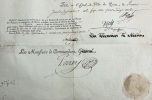


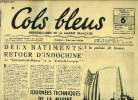
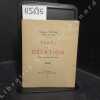
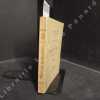
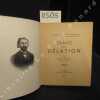

![[Lettre autographe signée, adressée du château de La Grange, un 8 frimaire/Autograph letter signed, addressed from Château de La Grange, 8 frimaire].. ...](https://static.livre-rare-book.com/pictures/TLS/5595_1_thumb.jpg)
![[Lettre autographe signée, adressée du château de La Grange, un 8 frimaire/Autograph letter signed, addressed from Château de La Grange, 8 frimaire].. ...](https://static.livre-rare-book.com/pictures/TLS/5595_2_thumb.jpg)


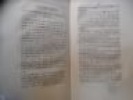
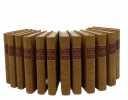



![Opinion de M. de Lafayette, Député de la Sarthe, sur le Projet de Loi relatif aux Elections. Séance du 27 mai 1820 [ Edition originale ]. LAFAYETTE, ...](https://static.livre-rare-book.com/pictures/CDL/59842_thumb.jpg)
![Opinion de M. de Lafayette, Député de la Sarthe, sur le Projet de Loi relatif aux Elections. Séance du 27 mai 1820 [ Edition originale ]. LAFAYETTE, ...](https://static.livre-rare-book.com/pictures/CDL/59842_2_thumb.jpg)
![Opinion de M. de Lafayette, Député de la Sarthe, sur le Projet de Loi relatif aux Elections. Séance du 27 mai 1820 [ Edition originale ]. LAFAYETTE, ...](https://static.livre-rare-book.com/pictures/CDL/59842_3_thumb.jpg)

